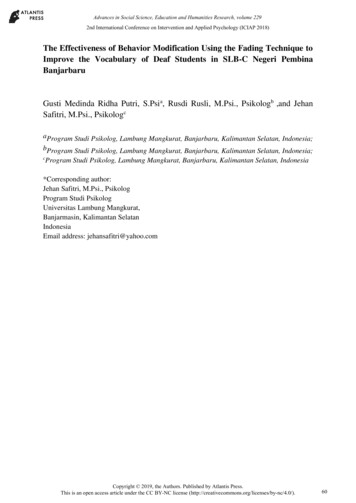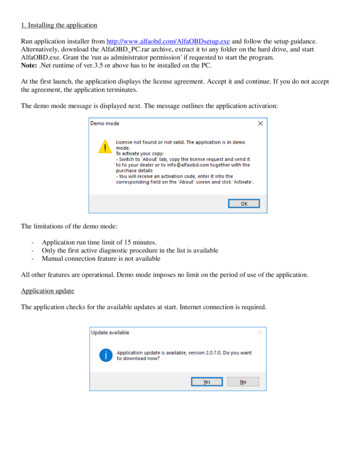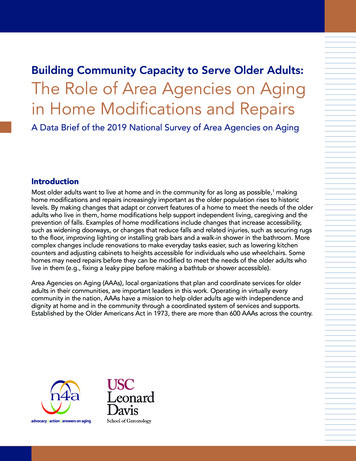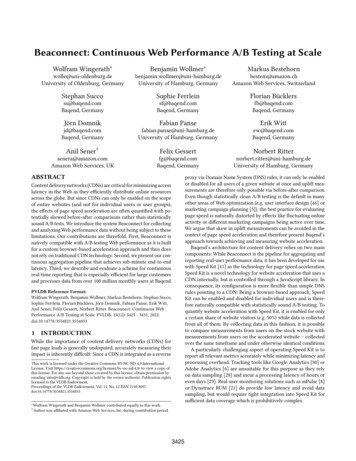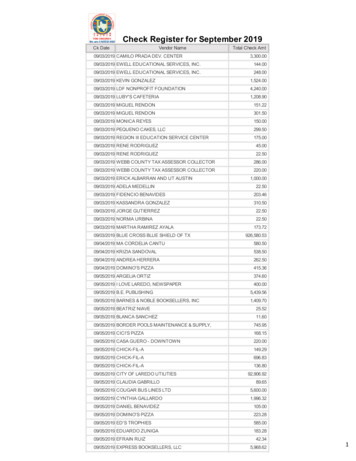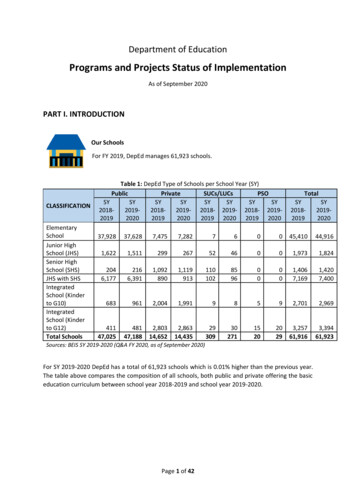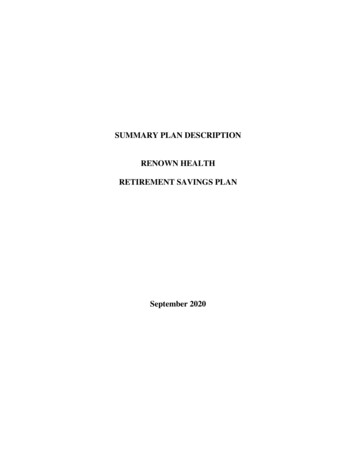
Transcription
GREATER LINCOLNWORKFORCE DEVELOPMENTBOARDA proud partner of the.------- amencanJObcenternetwork2019 Plan ModificationGreater Lincoln Workforce Development Area&Southeast RegionPrepared by theGreater Lincoln Workforce Development Board
Table of ContentsIntroduction .1Regional Plan Elements.2Local Plan Elements. 23Regional Signature Sheet. 54Local Signature Sheet. 55Local Assurances . 56
IntroductionThe plan modification for the Southeast Region and the Greater Lincoln Workforce DevelopmentArea has been prepared in compliance with the Nebraska Department of Labor’s State Policy onRegional and Local Plans, Change 4 and Nebraska Department of Labor’s Employment and TrainingNotice 18-03. The plan modification must be submitted to the Nebraska Department of Labor nolater than Monday, April 1, 2019.The Greater Lincoln Workforce Development Area is defined as Lancaster and Saunders Counties.The Southeast Region is defined as Fillmore, Gage, Jefferson, Johnson, Lancaster, Nemaha, Otoe,Pawnee, Richardson, Saline, Saunders, Seward, Thayer, and York Counties.The Greater Lincoln Workforce Development Board is the lead local board for this plan modification.The Greater Nebraska Workforce Development Board is the partnering local board. The regionalmodification must include signatures from the chairs of the lead and partnering local boards andChief Elected Officials of the planning region.The first section of the plan modification addresses regional plan elements including an analysis ofeconomic conditions, employer needs, job seeker characteristics, and the regional workforce. Servicestrategies are included to support regional economic growth and economic self-sufficiency.The second section covers local plan elements including a description of the one-stop deliverysystem, partner collaboration, and strategies and services to support the strategic vision and goalsidentified in the state plan.The Workforce Innovation and Opportunity Act (WIOA) is an equal opportunity program andauxiliary aids and services are available upon request to individuals with disabilities. The City ofLincoln complies with Title VI of the Civil Rights Act of 1964 and Section 504 of the Rehabilitation Actof 1973 guidelines. Ensuring the public’s access to public documents and participation in publicmeetings is a priority for the City of Lincoln. In the event you are in need of a reasonableaccommodation or access to language services, please contact the Director of Equity and Diversity,Lincoln Commission on Human Rights at 402-441-7624 as soon as possible to make your request.1
Regional Plan Elements1.Provide an analysis of regional economic conditions, including existing and emerging in-demandindustry sectors and occupations (see note at end of document), based on regional labor marketdata.The Southeast Nebraska Regional Planning Area as designated by the Governor under WIOA consistsof Lancaster, Seward, York, Fillmore, Saline, Gage, Thayer, Jefferson, Pawnee, Richardson, Johnson,Nemaha and Otoe counties plus the Greater Lincoln Workforce Development Area (GLWDA) whichadds Saunders county (Greater Lincoln WDA is comprised of Lancaster and Saunders countiesincluding the City of Lincoln). The Greater Lincoln Workforce Development Board is the lead localboard for this region. With a population of 425,446 that represents approximately 22.7% of thestate, the region has shown disparate population change with the GLWDA increasing at a rate of3.01% while the remainder of the SE Region decreased in population by 0.83% as estimated by thechange in population for the period 2010-2013. The average employment base is approximately223,366 employees.According to the Nebraska Department of Labor’s NEworks website unemployment hovers at 2.3%(GLWDA) and 2.6% (remaining counties) with an estimated 5,669 unemployed individuals within theregion. Average hourly wages range from 18.23/hour (SE Region) to 21.05/hour (GLWDA) withaverage annual wages of 37,908 and 43,784 respectively. Personal income has fluctuated withinthe SE Region whereas the Lincoln WIA has shown steady increases.The region is comprised of both urban and rural based characteristics that are reflected in theeconomic makeup of the area. Agriculture and Ag based manufacturing have a large presencewithin the counties, while the City of Lincoln has a more urban based economy including a robustFinance and Insurance based industry sector.Projected job growth for the area by 2026 is 22,702 jobs (11.28%) for the Lincoln MSA and 2,672 jobs(4.59%) for the Southeast Region.Personal Income - All Sources, Percent Change from previous year:SE/Greater Lincoln Regions, CountiesYearAverage, SE 2Average, Greater Lincoln
Personal Income (Thousands of dollars) – All Sources: SE/Greater Lincoln RegionsYearTotal, SE RegionTotal, Greater 232Existing and in-demand industries within the region are reflected in the following tables. The tablebelow shows the industries with the highest number of employees in the areas selected for the 2ndQuarter, 2018.Industry Employment DistributionGL Workforce Development AreaSoutheast RegionTotal, All lth Care and Social Assistance25,9067,261Confidential4,994Retail Trade19,0784,839Public Administration14,6443,756Accommodation and Food Services15,3273,177Wholesale Trade4,0822,099Construction9,5681,797Finance and Insurance9,6461,550IndustryEducational ServicesNebraska Department of Labor, Labor Market Information, Quarterly Census of Employment and WagesThe table below shows the industries with the highest total employment change in the GLWDA forthe 2016-2026 time period.Greater Lincoln Workforce Development Area: Industries by Projected GrowthRankIndustry2016 Estimated 2026 ProjectedTotal 2016-2026EmploymentEmployment Employment Change1Professional, Scientific, and TechnicalServices36,40243,8807,4782Ambulatory Health Care Services25,99033,2097,2193Social Assistance16,29320,5154,2224Nursing and Residential Care Facilities16,22520,1983,9735Specialty Trade Contractors24,15327,8333,6806Credit Intermediation and Related Activities17,57420,9983,4247Education Employment (private state local)22,04424,4732,4293
RankIndustry2016 Estimated 2026 ProjectedTotal 2016-2026EmploymentEmployment Employment Change8Food Services and Drinking Places13,72915,3961,6679Construction of Buildings4,4495,3569074,1864,81362710 Food and Beverage StoresSource: Nebraska Department of Labor, Labor Market Information, ProjectionsThe table below shows the industries with the highest total employment change in Southeast Region(2013 Def.), NE for the 2016-2026 time period.Southeast Region: Industries by Projected GrowthRankIndustry2016 Estimated 2026 ProjectedTotal 2016-2026EmploymentEmployment Employment Change1Food Manufacturing4,3585,1507922Education Employment (private state local)5,4155,7933783Hospital Employment (private state local)2,5482,7812334Crop Production5,0445,2472035Animal Production2,7162,8421266Truck Transportation5346411077Chemical Manufacturing470555858Support Activities for Agriculture and Forestry413491789Specialty Trade Contractors1,2161,2846810General Merchandise Stores1,2971,36164Source: Nebraska Department of Labor, Labor Market Information, Projections2. Provide an analysis of employment needs of employers in existing and emerging in-demandindustry sectors and occupations in the planning region based on regional labor market data.With an average civilian labor force of approximately 239,185, there were 6,394 available jobopenings advertised on-line within the Region and 32,465 available candidates for an average of 7.15candidates per job opening (January, 2019)The largest employers in the region include State Government, Healthcare, and Private Employers inthe Production and Insurance sectors.Among current job openings Healthcare, Government, and Education comprise the largest numberof opportunities.The table below shows the employers with the highest number of job openings advertised online inthe GLWDA on January 22, 20194
GLWDA: Employers by Number of Job OpeningsRankEmployer NameJob Openings1Bryan Health2972University of Nebraska-Lincoln2723Army National Guard1584Nebraska State Government1345Madonna Rehabilitation Hospitals756General Dynamics727Southeast Community College688Lincoln Public Schools659Catholic Health Initiatives5910Tabitha Health Care Services52The table below shows the employers with the highest number of job openings advertised online inSoutheast Region (2013 Def.), NE on January 22, 2019Southeast Region: Employers by Number of Job OpeningsRankEmployer NameJob Openings1AMERICOLD LOGISTICS582The Evangelical Lutheran Good Samaritan Society473Nebraska State Government424ShopKo Stores Operating Co., LLC325York General Health Care Services306Beatrice Community Hospital & Health Center237Home Instead, Inc.228Good Samaritan Society219McDonald's Corporation2010PETRO Stopping Centers19By 2026, industries with the largest number of projected employees include Education (29,623), FoodService (15,396), Professional & Scientific (10,901), and Animal Production (5,842).Industries with the largest projected percentage of growth through 2026 are reflected in thefollowing tables:The table below shows the industries with the highest total annual percent change in LincolnMetropolitan Statistical Area (2013 Def.) for the 2016-2026 time period.5
Lincoln Metropolitan Statistical Area: Industries by Projected Growth (% Change)2016 AnnualEmployment2026 ProjectedEmploymentPercent Change2016-2026Professional, Scientific, and Technical Services9,25010,90117.85%Arts, Entertainment, and 7.56%Health Care and Social Assistance26,14830,69717.40%Accommodation and Food Services15,18417,16113.02%Finance and Insurance13,45015,18212.88%Educational Services (including state & local gov’t)22,04424,47311.02%Management of Companies and 29.34%Retail Trade19,38921,1459.06%Other Services (except Government)8,4999,1838.05%Wholesale Trade4,4274,7737.82%Real Estate and Rental and Leasing1,7281,8597.58%Transportation and culture, Forestry, and Fishing3,1833,3485.18%8148342.46%440.00%Industry TitleAdministrative and Support and WasteManagement and Remediation ServicesUtilities (private state local)MiningSource: Nebraska Department of Labor, Labor Market Information, ProjectionsThe table below shows the industries with the highest total annual percent change in SoutheastRegion (2013 Def.), NE for the 2016-2026 time period.SE Economic Development Region: Industries by Projected Growth (% Change)Industry TitleManagement of Companies and Enterprises2016 AnnualEmployment2026 ProjectedEmploymentPercent ion and WarehousingArts, Entertainment, and Recreation414Real Estate and Rental and LeasingManufacturing8,927Educational Services (including state & local gov’t)5,415Finance and Insurance1,661Agriculture, Forestry, and 9.09%9.02%6.98%5.42%4.98%
Mining2016 AnnualEmploymentIndustry Title46Health Care and Social Assistance6,873Administrative and Support and Waste Managementand Remediation Services1,022ConstructionAccommodation and Food ServicesRetail Trade2026 ProjectedEmploymentPercent Change2016-20267,1684.29%Other Services (except 1%5,1051,4642,288-0.52%388-2.02%5,263Utilities (private state 4.12%1,476GovernmentWholesale Trade4.35%2,0145,011Professional, Scientific, and Technical Services480.75%-0.97%Source: Nebraska Department of Labor, Labor Market Information, ProjectionsThe table below shows the industries with the highest total employment change in LincolnMetropolitan Statistical Area (2013 Def.) for the 2016-2026 time period.Lincoln Metropolitan Statistical Area: Industries by Projected Growth(Employment Change inEmployment2016-2026Health Care and Social Assistance26,14830,6974,549Educational Services (including state and local gov)22,04424,4732,429Accommodation and Food Services15,18417,1611,977Retail Trade19,38921,1451,756Finance and Insurance13,45015,1821,732Professional, Scientific, and Technical ,675857Transportation and Warehousing10,46011,152692Other Services (except Government)8,4999,183684Arts, Entertainment, and Recreation3,4354,046611Administrative and Support and Waste Management andRemediation Services8,2638,749486Wholesale Trade4,4274,773346Management of Companies and dustry Title7
Industry TitleAgriculture, Forestry, and Change Real Estate and Rental and LeasingUtilities (private state local)Mining3,348165Source: Nebraska Department of Labor, Labor Market Information, ProjectionsThe table below shows the industries with the highest total employment change in Southeast Region(2013 Def.), NE for the 2016-2026 time period.Southeast Economic Development Region: Industries by Projected Growth(Employment Change)Industry Title2016 AnnualEmployment8,9278,1735,4152026 iculture, Forestry, and FishingEducational Services (including state and localgov’t)Health Care and Social Assistance6,8737,168Transportation and Warehousing1,4561,617Retail Trade5,0115,105Finance and Insurance1,6611,751Accommodation and Food Services3,2723,357Construction2,0142,097Arts, Entertainment, and Recreation414453Administrative and Support and Waste1,0221,061Management and Remediation ServicesGovernment5,2245,263Real Estate and Rental and Leasing165180Professional, Scientific, and Technical Services759772Management of Companies and Enterprises93105Other Services (except ilities (private state local)1,1361,125Wholesale Trade2,3002,288Source: Nebraska Department of Labor, Labor Market Information, Projections8Change inEmployment 1-12
Projected top growth occupations are reflected in the following tables.Lincoln Metropolitan Statistical Area: Long Term Occupational Projected Growth(Employment Change)2016 EstimatedEmployment2026 ProjectedEmploymentNumeric ChangeRegistered Nurses4,7025,218516Software Developers, Applications1,4131,880SOC TitleCombined Food Preparation and ServingWorkers, Including Fast FoodPersonal Care Aides456854821,9094841,0421,442400Heavy and Tractor-Trailer Truck Drivers6,4256,812387Customer Service Representatives4,7622,6102,976366Childcare Workers2,7643,127363Waiters and Waitresses2,9003,249349Maids and Housekeeping Cleaners2,1712,474303Stock Clerks and Order Fillers2,2832,582299Accountants and 83263Credit CounselorsRetail SalespersonsGeneral and Operations ManagersCarpenters1,4259145,2295,616Nursing AssistantsJanitors and Cleaners, Except Maids andHousekeeping CleanersOffice Clerks, General3875,1392,124Social and Human Service 772875,431Source: Nebraska Department of Labor, Labor Market Information254SE Region: Long Term Occupational Projected Growth (Employment Change)2016 EstimatedEmploymentSOC TitleMeat, Poultry, and Fish Cutters and Trimmers1,336Heavy and Tractor-Trailer Truck Drivers1,003Farmers, Ranchers, and Other Agricultural ManagersLaborers and Freight, Stock, and Material Movers, 04Farmworkers & Laborers, Crop, Nursery, and Greenhouse2,8229NumericChange1,623Combined Food Preparation and Serving Workers,Including Fast FoodPersonal Care Aides2026 ProjectedEmployment1,2052,90512310183
2016 EstimatedEmploymentSOC TitlePackers and Packagers, Hand524Teacher Assistants2026 ProjectedEmployment846Registered 45Janitors and Cleaners, Except Maids & HousekeepingCleaners834Industrial Machinery Mechanics3774291,4561,501Packaging and Filling Machine Operators and Tenders33538045First-Line Supervisors of Production and OperatingWorkers4965384251255240Elementary School Teachers, Except Special Education686Agricultural Equipment Operators510Farmworkers, Farm, Ranch, and Agricultural AnimalsMultiple Machine Tool Setters, Operators, and Tenders,Metal and Plastic890279Secondary School Teachers, Except Special andCareer/Technical Education567Maintenance and Repair Workers, General61056524543Source: Nebraska Department of Labor, Labor Market Information3. Provide an analysis of the knowledge and skills needed by job seekers to meet the employmentneeds of the employers in the region, including employment needs in in-demand industry sectorsand occupations.Based on employment demand, job skills and types of knowledge required by employers arereflected in the following tables.Lincoln Workforce Development Area: Advertised Job SkillsRankAdvertised Detailed Job SkillAdvertised Skill Group1Customer serviceCustomer Service Skills2Problem solvingBasic Skills3Interpersonal skillsInterpersonal skills4FlexibilityInterpersonal skills5Time managementBasic Skills6Positive attitudeInterpersonal skills7HonestyBasic Skills8Decision makingBasic Skills9MentoringInterpersonal skills10Business developmentBusiness Development SkillsSource: Online advertised jobs data10
SE Region: Advertised Job Skills TableRankAdvertised Detailed Job SkillAdvertised Skill Group1Customer serviceCustomer Service Skills2Problem solvingBasic Skills3Interpersonal skillsInterpersonal skills4WeldingWelding skills5FlexibilityInterpersonal skills6Positive attitudeInterpersonal skills7Time managementBasic Skills8Crisis interventionMental health counselor skills9Decision makingBasic Skills10Instructional designInstructor or Teacher SkillsSource: Online advertised jobs dataSkills and knowledge required by growth industries include the following:Growth IndustryEducation ServicesHealth CareAccommodation & Food ServiceRetail TradeFinance & InsuranceTransportation & WarehouseAgricultural/Forestry SupportManufacturingRequired Skills/Knowledge/Abilities Flexibility Communication skills Time management Interpersonal skills Housekeeping skills Customer service skills Laboratory technician skills Phlebotomist skills Problem solving skills Food preparation skills Dietary aide skills Customer service skills Basic skills Interpersonal skills Cashier skills Customer service skills Financial planning Interpersonal skills Basic skills Fork lift skills Interpersonal skills Basic skills Office skills Landscaping skills Bill & account collection skills Maintenance technician skills Interpersonal skills Basic skills Loss prevention skills11
4. Provide an analysis of the regional workforce, including current labor force employment andunemployment data, information on labor market trends, and educational and skill levels of theworkforce including individuals with barriers to employment.As mentioned in Section A1, unemployment currently hovers at 2.3% (GLWDA) and 2.6% (remainingcounties) with an estimated 5,669 unemployed individuals within the entire region. The civilian laborforce is estimated at 239,185 with 233,524 currently employed (January, 2019). Average hourlywages range from 18.23/hour (SE Region) to 21.05/hour (GLWDA) with average annual wages of 37,908 and 43,784 respectively.There are 11,490 available jobs posted on-line with an average of .053 unemployed individualsavailable per job (January, 2019)Employment trends for the period 2013-2017 are reflected in the following tables.Greater Lincoln Workforce Development AreaTime PeriodLabor ForceEmployedUnemployedUnemployment ast RegionTime PeriodLabor ForceEmployedUnemployedUnemployment 70453,3751,7064.10%3.10%3.10%3.10%The following three tables reflect the educational levels required by employers and those of theavailable workforce. The table immediately below shows the minimum level of education requestedby employers on job openings advertised online in the areas selected on January 21, 2019.12
Education Level of JobsEducation LevelGLWDASoutheast Region174118005741961 Year of College or a Technical or Vocational School472 Years of College or a Technical or Vocational School34Some College00Vocational School Certificate1718Associate's Degree6635Bachelor's Degree18443Master's Degree156Doctorate Degree28Specialized Degree (e.g. MD, DDS)21No Minimum Education RequirementLess than High SchoolHigh School Diploma or EquivalentThe table below shows the educational attainment of potential candidates in the workforce systemthat are looking for jobs in the GLWDA on January 29, 2019.Education Level of Available Candidates: Lincoln Workforce DevelopmentRankEducation LevelPotentialCandidatesPercentage of PotentialCandidates0N/A1No Minimum Education Requirement2Less than High School1,3677.75%3High School Diploma or Equivalent6,97039.52%41 Year of College or a Technical or Vocational School0N/A52 Years of College or a Technical or Vocational School0N/A6Some College10.01%7Vocational School Certificate6123.47%8Associate's Degree1,0055.70%9Bachelor's Degree2,85016.16%10Master's Degree1,1096.29%11Doctorate Degree810.46%12Specialized Degree (e.g. MD, DDS)390.22%13Not Specified0N/ASource: Individuals with active résumés in the workforce system.The table below shows the educational attainment of potential candidates in the workforce systemthat are looking for jobs in Southeast Region (2013 Def.), NE on January 29, 2019.13
Education Level of Available Candidates: SE RegionRankEducation LevelPotentialCandidatesPercentage of PotentialCandidates0N/A1No Minimum Education Requirement2Less than High School1,1498.04%3High School Diploma or Equivalent5,99841.97%41 Year of College or a Technical or Vocational School0N/A52 Years of College or a Technical or Vocational School0N/A6Some College10.01%7Vocational School Certificate4833.38%8Associate's Degree7665.36%9Bachelor's Degree2,03214.22%10 Master's Degree8255.77%11 Doctorate Degree550.39%12 Specialized Degree (e.g. MD, DDS)310.22%13 Not Specified0N/ASource: Individuals with active résumés in the workforce system.The following three tables reflect the skill levels (as defined by work experience) required byemployers and those of the available workforce. The table immediately below shows the minimumrequired work experience on job openings advertised online in the areas selected on January 21,2019 (Jobs De-duplication Level 2).Work Experience of JobsExperienceGLWDASoutheast Region (2013 Def.)Entry Level394195Less than 1 year131581 Year to 2 Years4,3911,0672 Years to 5 Years111285 Years to 10 Years134More than 10 Years1114
The table below shows the work experience of potential candidates in the workforce system that arelooking for jobs in GLWDA on January 29, 2019.Work Experience of Available Candidates: Lincoln Workforce Development AreaRankExperiencePotential CandidatesPercentage of Potential Candidates0N/A1Entry Level2Less than 1 year1,1936.66%31 Year to 2 Years5703.18%42 Years to 5 Years1,6199.03%55 Years to 10 Years2,58314.41%6More than 10 Years11,95766.72%Source: Individuals with active résumés in the workforce system.The table below shows the work experience of potential candidates in the workforce system that arelooking for jobs in Southeast Region (2013 Def.), NE on January 29, 2019.Work Experience of Available Candidates: SE RegionRankExperiencePotential CandidatesPercentage of Potential Candidates0N/A1Entry Level2Less than 1 year1,0667.34%31 Year to 2 Years4843.33%42 Years to 5 Years1,3799.50%55 Years to 10 Years2,14714.78%6More than 10 Years9,44865.05%Source: Individuals with active résumés in the workforce system.5. Provide an analysis of workforce development activities, including education and trainingactivities, in the region. This analysis must include the strengths and weaknesses of workforcedevelopment activities and capacity to provide the workforce development activities to addressthe education and skill needs of the workforce, including individuals with barriers to employment,and the employment needs of employers.The region is well positioned to supply education and training to fill workforce needs through anumber of avenues. Southeast Community College (SCC) has an extensive selection of careertechnical education programs on the Eligible Training Provider list. In addition, there are a numberof 4-year institutions in the area including the University of Nebraska, Bellevue and DoaneUniversities as well as specialized training programs run by Lincoln Electrical Contractors, theAssociated Builders & Contractors, and Bryan College of Health Sciences. Adult Education andEnglish Language Learner classes are available from SCC and the Lincoln Literacy Council.The American Job Centers located in Lincoln and Beatrice have strong relationships with localemployers. These relationships have and will continue to meet employer needs by providing On-theJob training and direct placement opportunities for job seekers.15
With respect to individuals with barriers to employment, on-going partnerships with variousorganizations that serve such individuals have been long standing. These organizations and thenumber of clients they serve are listed below.Partner ProgramNebraska Department of Labor (UI, Trade, Veterans, and Wagner-Peyser)Adult Education/Family Literacy-SCC & & NE Department of EducationWIOA Adult/Dislocated Worker/Youth - ResCareCareer/Tech Ed - SCCHUD-Lincoln Housing AuthorityCSBG-Community Action of Lancaster & SaundersMigrant & Seasonal Farmworkers-ProteusNative American Programs-Indian CenterSenior Community Service Employment ProgramVocational Rehabilitation and NCBVI combinedTemporary Assistance for Needy Families (TANF) program-DHHSClients Served2,9279771542,1731286916N/A461,4731,978In addition, the Strategic Initiatives Committee of the GLWDB has recently engaged in discussionswith Community Corrections to brainstorm ways to collaborate on assisting participants in their reentry program.Strengths and WeaknessesComprised of two (2) local workforce development areas (Greater Lincoln and a portion of thesoutheast region of Greater Nebraska), regional workforce development activities include thefollowing strengths: Support of an engaged lead local board, the Greater Lincoln Workforce Development Board,which receives financial support from City of Lincoln General Funds. A strong post-secondary community college, Southeast Community College (SCC), which hasthree campuses-Lincoln, Beatrice, and Milford. Community Learning Centers created by SCC in Wahoo, York, Plattsmouth, Nebraska City,Falls City, and Hebron. Multiple four-year educational institutions. American Job Centers in Beatrice and Lincoln. Partnerships with multiple employer driven initiatives focused on in-demand and growthoccupations.Weaknesses include: Uncertainty of federal funding; Re-education of leadership within the City of Lincoln due to upcoming Mayoral change; Employer perception of lack of workers especially in certain skill areas Continued confusion caused by the inclusion of Saunders county as part of the GreaterLincoln Local Workforce Development Area16
6. Describe the strategic vision of the lead and partnering local board to support regional economicgrowth and economic self-sufficiency. This must include goals:a. for preparing an educated and skilled workforce (including youth and individuals withbarriers to employment); andb. relating to the performance accountability measures based on the performance indicatorsdescribed in 20 CFR § 677.155(a)(1).a. The Greater Lincoln Workforce Development Board has embraced the State’s strategic vision ofhaving a regional workforce system that delivers coordinated, proactive, responsive andadaptable services for jobseekers and employers to maximize opportunities for earning, learning,and living.In addition, the Board has established a Strategic Initiatives committee in an effort to identify theareas most likely to create opportunities to support regional economic growth and economicself-sufficiency. Specifically, the purpose of the Committee is to: Connect local and regional business, education and economic development initiatives Promote sector strategies for target industries Promote partnerships within the local and regional one stop systems and American JobCenters (AJC) Develop service strategies for specific populations such as yo
The Workforce Innovation and Opportunity Act (WIOA) is an equal opportunity program and auxiliary aids and services are available upon request to individuals with disabilities. The City of Lincoln complies with Title VI of the Civil Rights Act of 1964 and Section 504 of the Rehabilitation Act of 1973 guidelines.


